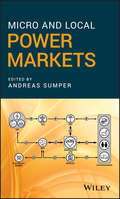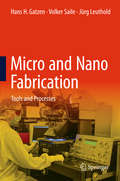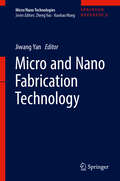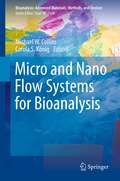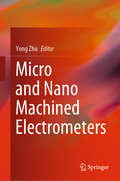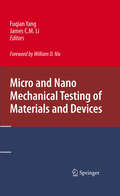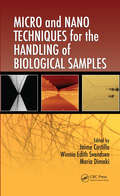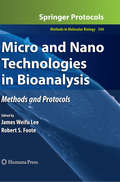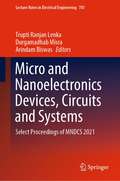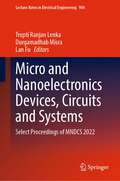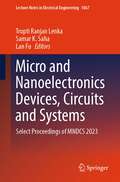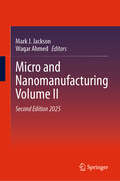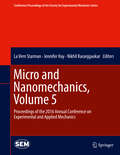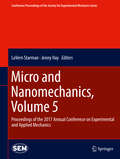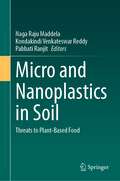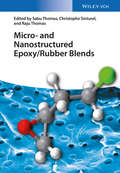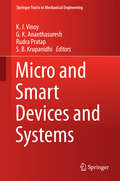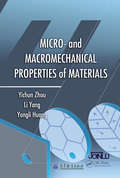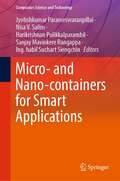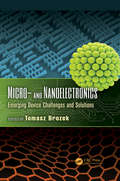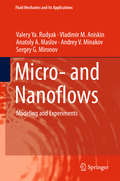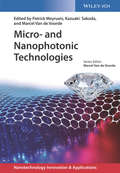- Table View
- List View
Micro and Local Power Markets
by Andreas SumperIntroduces readers to micro and local power markets and their use for local initiatives, grid integration, and future applications This book provides the basis for understanding micro power markets, emphasizing its application for local initiatives, the grid integration of renewable-based generation, and facilitating the decarbonization of the future electrical networks. It gives readers a comprehensive overview of the market operation, and highlights the basis of the design of local and micro markets. Micro and Local Power Markets starts by covering the economics and basic principle of power markets, including the fundamentals of the power trading (for both wholesale and local markets). Following a definition of both micro and local (technical and economic aspects) power markets, the book then looks at the organization of such markets. It describes the design of those power markets, isolated from the wholesale markets, and examines the methodologies of the interaction between these power markets and wholesale markets. The book also presents cognitive business models for micro and local power markets, as well as the regulatory issues concerning them. Introduces the basic principle of power markets Defines micro and local power markets Outlines the design of micro and local power markets, including the principles, as well as the trading schemes, flexibility, and services Discusses methodologies of the interaction between micro and local power markets and wholesale markets Presents business models for micro and local power markets Summarizes regulatory issues around micro and local power markets Micro and Local Power Markets is an ideal book for upper undergraduate students in engineering, as well as for early researchers in the energy sector. It is also recommended for any scientist and engineer being introduced to the field of power systems and their organization.
Micro and Nano Fabrication
by Hans H. Gatzen Volker Saile Jürg LeutholdFor Microelectromechanical Systems (MEMS) and Nanoelectromechanical Systems (NEMS) production, each product requires a unique process technology. This book provides a comprehensive insight into the tools necessary for fabricating MEMS/NEMS and the process technologies applied. Besides, it describes enabling technologies which are necessary for a successful production, i. e. , wafer planarization and bonding, as well as contamination control.
Micro and Nano Fabrication Technology (Micro/Nano Technologies)
by Jiwang YanThis volume focuses on the state-of-the-art micro/nanofabrication technologies for creating miniature structures with high precision. These multidisciplinary technologies include mechanical, electrical, optical, physical, and chemical methods, as well as hybrid processes, covering subtractive and additive material manufacturing, as well as net-shape manufacturing. The materials the volume deals with include metals, alloys, semiconductors, polymers, crystals, glass, ceramics, composites, and nanomaterials. The volume is composed of 30 chapters, which are grouped into five parts. Engaging with the latest research in the field, these chapters provide important perspectives on key topics, from process developments at the shop level to scientific investigations at the academic level, offering both experimental work and theoretical analysis. Moreover, the content of this volume is highly interdisciplinary in nature, with insights from not only manufacturing technology but also mechanical/material science, optics, physics, chemistry, and more.
Micro and Nano Flow Systems for Bioanalysis
by Michael W. Collins Carola S. KoenigMicro and Nano Flow Systems for Bioanalysis addresses the latest developments in biomedical engineering at very small scales. It shows how organic systems require multi-scale understanding in the broadest sensewhether the approach is experimental or mathematical, and whether the physiological state is healthy or diseased. Micro-and nano-fluidics represent key areas of translational research in which state-of-the-art engineering processes and devices are applied to bedside monitoring and treatment. By applying conventional micro- and nano-engineering to complex organic solids, fluids, and their interactions, leading researchers from throughout the world describe methods and techniques with great potential for use in medicine and clinical practice. Coverage includes the seeming plethora of new, fine-scale optical methods for measuring blood flow as well as endothelial activation and interaction with tissue. Generic areas of modeling and bioelectronics are also considered. In keeping with the recurring theme of medicine and clinical practice, approximately half of the chapters focus on the specific application of micro- and nano- flow systems to the understanding and treatment of cancer and cardiovascular diseases. This book developed from an Expert Overview Session on "Micro & Nano Flows in Medicine: the way ahead" at the 3rd Micro and Nano Flows Conference (MNF2011) held in Thessaloniki, Greece. Additional chapters were included to enhance the international, state-of-the-art coverage.
Micro and Nano Machined Electrometers
by Yong ZhuThis book reviews advances in cutting-edge micro-/nano-electrometers, and discusses the technological challenges involved in their practical implementation. The detection of electrostatic charge has a wide range of applications in ionization chambers, bio-analyte and aerosol particle instruments, mass spectrometers, scanning tunneling microscopes, and even quantum computers. Designing micro-/nano-electrometers (also known as charge sensors) for electrometry is considered vital because of the charge sensitivity and resolution issues at micro-/nano-scales. The remarkably dynamic microelectromechanical systems (MEMSs)/nanoelectromechanical systems (NEMSs), and advances in solid-state electronics, hold considerable potential for the design and fabrication of extremely sensitive charge sensors.
Micro and Nano Machining of Engineering Materials: Recent Developments (Materials Forming, Machining and Tribology)
by J. Paulo Davim Kaushik Kumar Divya Zindani Nisha KumariThis book covers the recent developments in the production of micro and nano size products, which cater to the needs of the industry. The processes to produce the miniature sized products with unique characteristics are addressed. Moreover, their application in areas such as micro-engines, micro-heat exchangers, micro-pumps, micro-channels, printing heads and medical implants are also highlighted. The book presents such microsystem-based products as important contributors to a sustainable economy. The recent research in this book focuses on the development of new micro and nano manufacturing platforms while integrating the different technologies to manufacture the micro and nano components in a high throughput and cost effective manner. The chapters contain original theoretical and applied research in the areas of micro- and nano-manufacturing that are related to process innovation, accuracy, and precision, throughput enhancement, material utilization, compact equipment development, environmental and life-cycle analysis, and predictive modeling of manufacturing processes with feature sizes less than one hundred micrometers.
Micro and Nano Mechanical Testing of Materials and Devices
by James C.M. Li Fuqian YangNanoscale and nanostructured materials have exhibited different physical properties from the corresponding macroscopic coarse-grained materials due to the size confinement. As a result, there is a need for new techniques to probe the mechanical behavior of advanced materials on the small scales. Micro and Nano Mechanical Testing of Materials and Devices presents the latest advances in the techniques of mechanical testing on the micro- and nanoscales, which are necessary for characterizing the mechanical properties of low-dimensional materials and structures. Written by a group of internationally recognized authors, this book covers topics such as: Techniques for micro- and nano- mechanical characterization; Size effects in the indentation plasticity; Characterization of low-dimensional structure including nanobelts and nanotubes; Characterization of smart materials, including piezoelectric materials and shape memory alloys; Analysis and modeling of the deformation of carbon-nanotubes. Micro and Nano Mechanical Testing of Materials and Devices is a valuable resource for engineers and researchers working in the area of mechanical characterization of advanced materials.
Micro and Nano Techniques for the Handling of Biological Samples
by Jaime Castillo-Leon Winnie Edith Svendsen Maria DimakiSeveral micro- and nanomanipulation techniques have emerged in recent decades thanks to advances in micro- and nanofabrication. For instance, the atomic force microscope (AFM) uses a nano-sized tip to image, push, pull, cut, and indent biological material in air, liquid, or vacuum. Using micro- and nanofabrication techniques, scientists can make ma
Micro and Nano Technologies in Bioanalysis
by James W. Lee Robert S. FooteIn recent years, large-scale advances in technology have led to greater understanding of the world on a much tinier scale: the biomolecular level. In Micro and Nano Technologies in Bioanalysis: Methods and Protocols, expert researchers from across the globe explore the technology which makes this analysis possible, investigating the worlds of microfluidics and nanotechnologies, and examining physical science techniques for the separation, detection, manipulation, and analysis of biomolecules. This volume contains innovative protocols on the application of microfluidics and the utilization of physical science-related technologies that will prove to be invaluable in the field of molecular biology. Chapters contain cutting edge applications of emerging nanotechnologies, including quantum dots and molecular fluorescence for the imaging and tracking of biomolecules. Composed in the highly successful Methods in Molecular BiologyTM series format, each chapter contains a brief introduction, step-by-step methods, a list of necessary materials, and a Notes section which shares tips on troubleshooting and avoiding known pitfalls. Comprehensive and groundbreaking, Micro and Nano Technologies in Bioanalysis: Methods and Protocols is a necessary tool for cellular biologists, biochemists, microbiologists, geneticists and medical researchers alike.
Micro and Nanoelectronics Devices, Circuits and Systems: Select Proceedings of MNDCS 2021 (Lecture Notes in Electrical Engineering #781)
by Arindam Biswas Trupti Ranjan Lenka Durgamadhab MisraThe book presents select proceedings of the International Conference on Micro and Nanoelectronics Devices, Circuits and Systems (MNDCS-2021). The volume includes cutting-edge research papers in the emerging fields of micro and nanoelectronics devices, circuits, and systems from experts working in these fields over the last decade. The book is a unique collection of chapters from different areas with a common theme and will be immensely useful to academic researchers and practitioners in the industry who work in this field.
Micro and Nanoelectronics Devices, Circuits and Systems: Select Proceedings of MNDCS 2022 (Lecture Notes in Electrical Engineering #904)
by Trupti Ranjan Lenka Durgamadhab Misra Lan FuThis book presents select proceedings of the International Conference on Micro and Nanoelectronics Devices, Circuits and Systems (MNDCS-2022). The book includes cutting-edge research papers in the emerging fields of micro and nanoelectronics devices, circuits, and systems from experts working in these fields over the last decade. The book is a unique collection of chapters from different areas with a common theme and is immensely useful to academic researchers and practitioners in the industry who work in this field.
Micro and Nanoelectronics Devices, Circuits and Systems: Select Proceedings of MNDCS 2023 (Lecture Notes in Electrical Engineering #1067)
by Samar K. Saha Trupti Ranjan Lenka Lan FuThis book presents select proceedings of the International Conference on Micro and Nanoelectronics Devices, Circuits and Systems (MNDCS-2023). The book includes cutting-edge research papers in the emerging fields of micro and nanoelectronics devices, circuits, and systems from experts working in these fields over the last decade. The book is a unique collection of chapters from different areas with a common theme and is immensely useful to academic researchers and practitioners in the industry who work in this field.
Micro and Nanomanufacturing Volume II
by Mark J. Jackson Waqar AhmedThis completly revised new edition offers a comprehensive treatment of micro and nanofabrication techniques and applies established and research laboratory manufacturing techniques to various materials. Designed as a companion volume to the book Micro and Nanomanufacturing, it covers topics such as aligned nanowire growth, molecular dynamics simulation of nanomaterials, atomic force microscopy for microbial cell surfaces, 3D printing of pharmaceuticals, microvascular coaptation methods, and more. The chapters also cover a wide variety of applications in areas such as surgery, auto components, living cell detection, dentistry, nanoparticles in medicine, and aerospace components, with six brand new chapters covering applications including the role of nanotechnology and nanomaterials in the manufacture of Lithium-ion batteries for electric vehicles, the incineration of waste materials, the manufacturing of cosmetics, sputtered thin films for biomedical applications, and the manufacture of nanofibers using electrospinning. Micro and Nanomanufacturing Volume II is an ideal text for professionals working in the field and for graduate students in micro and nanomanufacturing courses.
Micro and Nanomechanics, Volume 5
by Jennifer Hay La Vern Starman Nikhil KaranjgaokarMicro-and Nanomechanics, Volume 5 of the Proceedings of the 2016 SEM Annual Conference & Exposition on Experimental and Applied Mechanics, the fifth volume of ten from the Conference, brings together contributions to this important area of research and engineering. The collection presents early findings and case studies on a wide range of areas, including: MEMS: Materials & Interfaces Microscale & Microstructural Effects on Mechanical Behavior Novel Nano-scale Probes Nanoindentation & Beyond Nanomechanics Dynamic Micro/Nano Mechanics
Micro and Nanomechanics, Volume 5
by Lavern Starman Jenny HayMicro-and Nanomechanics, Volume 5 of the Proceedings of the 2017 SEM Annual Conference & Exposition on Experimental and Applied Mechanics, the fifth volume of nine from the Conference, brings together contributions to this important area of research and engineering. The collection presents early findings and case studies on a wide range of areas, including: MEMS & Energy Harvesting 1D & 2D Materials/Fabrication Micro/Nano Microscopy Techniques Nanomechanics Flexible & Stretchable Electronics Interfaces & Adhesion
Micro and Nanoplastics in Soil: Threats to Plant-Based Food
by Naga Raju Maddela Kondakindi Venkateswar Reddy Pabbati RanjitThis contributed volume gives a state-of-the-art overview of microplastics and nanoplastics (MPs and NPs) in soils and their relationship with growing plants. Through chapters contributed by a wide variety of researchers, the book offers readers an understanding of MP and NP adsorption, uptake, and effects, as well as implications for trophic transmission, food safety, and security. Cutting-edge topics such as trophic transfer and remediation of MPs and NPs in soil samples are also addressed. The book begins with a primer on terrestrial MPs and NPs, their effects on terrestrial plants, and how these contaminants affect human populations. From there, the volume is split into four sections which address both problems caused by MPs and NPs in soil and potential remediation solutions. The first section deals with the mechanics of how MPs and NPs pollute soils and how toxic chemicals affect the soil profile and its flora, fauna and microbes. The second section of the book discusses trophic transfer of MPs and NPs from roots to shoot, shoot to leaves, and then to fruits. The third section details the threats to humans that are present as a result of MPs and NPs in soils. The fourth and last section gives covers bioremediation techniques that can be employed in order to reclaim polluted soils.
Micro and Nanostructured Epoxy / Rubber Blends
by Sabu Thomas Christophe Sinturel Raju ThomasEpoxy resins are polymers which are extensively used as coating materials due to their outstanding mechanical properties and good handling characteristics. A disadvantage results from their high cross-link density: they are brittle and have very low resistance to crack growth and propagation. This necessitates the toughening of the epoxy matrix without impairing its good thermomechanical properties. The final properties of the polymer depend on their structure. The book focuses on the microstructural aspects in the modification of epoxy resins with low molecular weight liquid rubbers, one of the prime toughening agents commonly employed. The book follows thoroughly the reactions of elastomer-modified epoxy resins from their liquid stage to the network formation. It gives an in-depth view into the cure reaction, phase separation and the simultaneous development of the morphology. Chapters on ageing, failure analysis and life cycle analysis round out the book.
Micro and Smart Devices and Systems
by K. J. Vinoy G. K. Ananthasuresh Rudra Pratap S. B. KrupanidhiThe book presents cutting-edge research in the emerging fields of micro, nano and smart devices and systems from experts working in these fields over the last decade. Most of the contributors have built devices or systems or developed processes or algorithms in these areas. The book is a unique collection of chapters from different areas with a common theme and is immensely useful to academic researchers and practitioners in the industry who work in this field.
Micro- and Macromechanical Properties of Materials (ISSN)
by Li Yang Yichun Zhou Yongli HuangThis is an English translation of a Chinese textbook that has been designated a national planned university textbook, the highest award given to scientific textbooks in China. The book provides a complete overview of mechanical properties and fracture mechanics in materials science, mechanics, and physics. It details the macro- and micro-mechanical properties of metal structural materials, nonmetal structural materials, and various functional materials. It also discusses the macro and micro failure mechanism under different loadings and contains research results on thin film mechanics, smart material mechanics, and more.
Micro- and Nano-Scale Sensors and Transducers
by Ezzat G. BakhoumThe rapidly emerging fields of nanotechnology and nano-fabrication have enabled the creation of new sensors with dramatic improvements in sensitivity and range, along with substantial miniaturization. And, although there are many books on nanotechnology, recent advances in micro and nano-scale sensors and transducers are not adequately represented
Micro- and Nano-containers for Smart Applications (Composites Science and Technology)
by Jyotishkumar Parameswaranpillai Sanjay Mavinkere Rangappa Harikrishnan Pulikkalparambil Nisa V. Salim Ing. habil Suchart SiengchinThis book comprehensively summarizes the recent achievements and trends in encapsulation of micro- and nanocontainers for applications in smart materials. It covers the fundamentals of processing and techniques for encapsulation with emphasis on preparation, properties, application, and future prospects of encapsulation process for smart applications in pharmaceuticals, textiles, biomedical, food packaging, composites, friction/wear, phase change materials, and coatings. Academics, researchers, scientists, engineers, and students in the field of smart materials will benefit from this book.
Micro- and Nanoelectronics: Emerging Device Challenges and Solutions (Devices, Circuits, and Systems #35)
by Tomasz BrozekMicro- and Nanoelectronics: Emerging Device Challenges and Solutions presents a comprehensive overview of the current state of the art of micro- and nanoelectronics, covering the field from fundamental science and material properties to novel ways of making nanodevices. Containing contributions from experts in both industry and academia, this cutting-edge text: Discusses emerging silicon devices for CMOS technologies, fully depleted device architectures, characteristics, and scaling Explains the specifics of silicon compound devices (SiGe, SiC) and their unique properties Explores various options for post-CMOS nanoelectronics, such as spintronic devices and nanoionic switches Describes the latest developments in carbon nanotubes, iii-v devices structures, and more Micro- and Nanoelectronics: Emerging Device Challenges and Solutions provides an excellent representation of a complex engineering field, examining emerging materials and device architecture alternatives with the potential to shape the future of nanotechnology.
Micro- and Nanoflows: Modeling And Experiments (Fluid Mechanics And Its Applications Ser. #118)
by Valery Ya. Rudyak Vladimir M. Aniskin Anatoly A. Maslov Andrey V. Minakov Sergey G. MironovThis book describes physical, mathematical and experimental methods to model flows in micro- and nanofluidic devices. It takes in consideration flows in channels with a characteristic size between several hundreds of micrometers to several nanometers. Methods based on solving kinetic equations, coupled kinetic-hydrodynamic description, and molecular dynamics method are used. Based on detailed measurements of pressure distributions along the straight and bent microchannels, the hydraulic resistance coefficients are refined. Flows of disperse fluids (including disperse nanofluids) are considered in detail. Results of hydrodynamic modeling of the simplest micromixers are reported. Mixing of fluids in a Y-type and T-type micromixers is considered. The authors present a systematic study of jet flows, jets structure and laminar-turbulent transition. The influence of sound on the microjet structure is considered. New phenomena associated with turbulization and relaminarization of the mixing layer of microjets are discussed. Based on the conducted experimental investigations, the authors propose a chart of microjet flow regimes. When addressing the modeling of microflows of nanofluids, the authors show where conventional hydrodynamic approaches can be applied and where more complicated models are needed, and they analyze the hydrodynamic stability of the nanofluid flows. The last part of the book is devoted the statistical theory of the transport processes in fluids under confined conditions. The authors present the constitutive relations and the formulas for transport coefficients. In conclusion the authors present a rigorous analysis of the viscosity and diffusion in nanochannels and in porous media.
Micro- and Nanomanipulation Tools
by Yu Sun Gary K. Fedder Osamu Tabata Christofer Hierold Jan G. Korvink Oliver Brand Xinyu LiuCombining robotics with nanotechnology, this ready reference summarizes the fundamentals and emerging applications in this fascinating research field. This is the first book to introduce tools specifically designed and made for manipulating micro- and nanometer-sized objects, and presents such examples as semiconductor packaging and clinical diagnostics as well as surgery. The first part discusses various topics of on-chip and device-based micro- and nanomanipulation, including the use of acoustic, magnetic, optical or dielectrophoretic fields, while surface-driven and high-speed microfluidic manipulation for biophysical applications are also covered. In the second part of the book, the main focus is on microrobotic tools. Alongside magnetic micromanipulators, bacteria and untethered, chapters also discuss silicon nano- and integrated optical tweezers. The book closes with a number of chapters on nanomanipulation using AFM and nanocoils under optical and electron microscopes. Exciting images from the tiniest robotic systems at the nano-level are used to illustrate the examples throughout the work. A must-have book for readers with a background ranging from engineering to nanotechnology.
Micro- and Nanophotonic Technologies
by Marcel Van de Voorde Kazuaki Sakoda Patrick MeyrueisEdited and authored by leading experts from top institutions in Europe, the US and Asia, this comprehensive overview of micro- and nanophotonics covers the physical and chemical fundamentals, while clearly focusing on the technologies and applications in industrial R&D. As such, the book reports on the four main areas of telecommunications and display technologies; light conversion and energy generation; light-based fabrication of materials; and micro- and nanophotonic devices in metrology and control.
